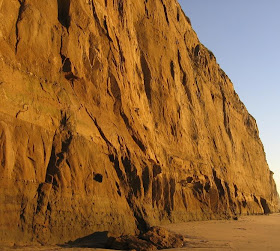It's approximately four in the AM in beautiful Long Island, New York, and this most recent blog post is brought to you by insomnia! I tend to not fare well in unfamiliar hotel rooms unless I'm relatively exhausted. Even though I'm running on a total of four hours of sleep since the night before I flew out to New York, I fared pretty well today. Tomorrow, I have a visit to the American Museum of Natural History in NYC, and Jonathan Geisler and I will be examining globicephaline dolphin skulls; the Globicephalinae are a clade of delphinids (oceanic dolphins) including pilot whales (Globicephala), Risso's Dolphin (Grampus), and false killer whales (Pseudorca). We're working on a short article together on a very fragmentary large odontocete skull from the Purisima Formation in Santa Cruz that shares some features in common with Globicephala.
But I'll talk more about that project later. More importantly, over this last weekend my first article was published - "Mammalian bite marks on juvenile fur seal bones from the late Neogene Purisima Formation of central California", which I coauthored with my friend and colleague Frank Perry of the Santa Cruz Museum of Natural History. And, oddly enough, right as I am typing this up now, I see that my friend Dr. Alton "Butch" Dooley at the VMNH has already beat me to the punchline (thanks for the free publicity, Butch!), and
has discussed my new paper on his blog, and compared it with some similar bite marks on proboscidean and chalicothere postcrania. Seeing as this is my first published article, I'll go a bit more in depth this time and post this in two or three parts.

The story starts on Christmas day, 2008. As I've alluded to before, winter is one of the best times to go out to the coast and do fieldwork. I suffered through some pretty intense, cold, biting weather this winter - I do not advise wearing hiking sandals on the beach and crossing streams in 45 degree weather with 40mph wind. That hurts. Anyway, now I'm rambling. I left our annual (gigantic) family Christmas dinner in Marin County and went to bed early, planning to take advantage of a favorable tide the day after Christmas. While out on the coast, I saw a boulder of a shellbed that is not normally accessible that had fallen on the beach, and a cute little brown object sticking out of it. Enough was exposed to identify it as a radius (forearm bone) of a juvenile fur seal. The specimen is tiny, and is only 69mm in length; this specimen, however, is lacking the proximal and distal ("elbow" and "wrist" ends of the bone, respectively) epiphyses (epiphyses are the ends of long bones which at birth are unfused, and fuse onto the middle 'shaft' of the bone later in life; the joint they fuse at is sometimes called the 'growth plate', and the fusion of epiphyses is what results in the decreased number of bones in adults relative to the higher number of bones in infants).

The fossil fur seal radius, UCMP 219009, in lateral (left), medial (center), and a magnified image of the bite mark (right).
When I prepared the bone from the soft shelly sandstone later that evening, I found a strange hole on the medial (medial means the side fo the radius closer to the body) side of the bone. This hole had a ring fracture around it, and a depressed ring of the bone's surface was adjacent to the hole itself. Pushed down into the hole was a fragment of the bone surface that had formerly occuppied the middle of the hole. Most importantly, when I prepared this fossil, there was sandstone filling in this feature, and because I was very careful and collected the bone in a block of sandstone, I knew that I had not damaged the specimen, and that this feature had not been formed after fossilization (i.e. it could not have been damaged when it was exposed, because the side with the puncture mark was embedded in sediment). Additionally, there were no hard objects such as a pebble or a shell that could have been pushed into the bone surface - sediment becomes compacted after burial, due to the immense pressures induced by trillions upon trillions of tons of rock overhead. Diagenetic compaction could push a pebble or an invertebrate shell into the bone surface and cause a similar puncture mark. Incidentally, bone can as well - a cranium of Herpetocetus bramblei I am working on describing with Jonathan Geisler has a similar puncture to those reported here, but the end of the jugal bone actually was lodged into the hole, probably as a result of diagenetic compaction. That would make a great paper, too, come to think of it...
Needless to say I was pretty confused at first, and I held off on interpreting it immediately, until I had read some more literature in order to come to a more informed decision on what I thought it was. I've written enough for now, so I'll continue this in a following post.
See also:
Dr. Alton Dooley's blog post about this and other bite marks at Updates from the Vertebrate Paleontology Lab.Boessenecker, R.W. and F.A. Perry. 2011. Mammalian bite marks on juvenile fur seal bones from the late Neogene Purisima Formation of Central California. Palaios 26:2:115-120.
Abstract.
Paper at Bioone.org.
 The right dentary of UCMP 85431. Scale bar =10cm. From Boessenecker (2011).
The right dentary of UCMP 85431. Scale bar =10cm. From Boessenecker (2011).























